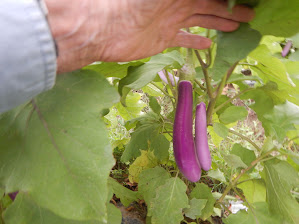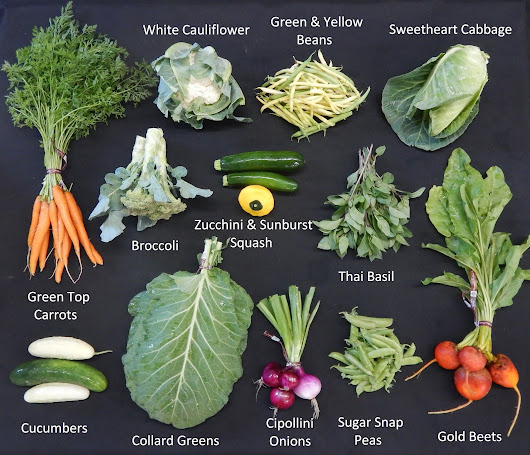 |
| 2022 Porcelain Garlic Drying in the Greenhouse |
by Richard de Wilde
We finished our garlic harvest with 48,000 bulbs of medium to large size garlic. The harvest actually went quite smoothly this year with only one interruption due to rain. We initiated harvest a little bit ahead of schedule knowing there were chances of rain in the forecast, so we had a little buffer and could pause harvest for a few days without it causing a setback. In most years we have to hurry and hustle to get it all harvested before a rain, in between rains, after a rain for fear that the longer we leave it the greater the chance of rot. But this year we just paced ourselves over several days without a crazy rush! Our harvest is drying in the greenhouses right now and before the end of this week we’ll start the process of topping the garlic and then sorting and crating to put it into storage. The smallest bulbs, including some that were extra from our green garlic planting, will be used for next year’s green garlic, planted 1-2 inches apart. Most of the largest premium bulbs, about 15,000 total, will be set aside and saved to plant next year’s main garlic crop. We’ll tuck it away in the cooler to keep it safe and dry until mid-October when we pull out these beautiful bulbs and “crack” them to separate the cloves for planting.
%20Resized.JPG) |
| Garlic sprouts poking through the thick straw mulch in March |
Once planted, we’ll cover the beds with a layer of rye straw mulch to insulate the garlic over the winter and will hold the mulch in place by covering the entire field with a huge row cover secured with sand bags to keep it from blowing away over the winter. We’ll also put up a deer fence to deter our deer friends from tromping and digging in the field over the winter.
Many people think farmers are crazy to take the best garlic they can produce, forfeit a sale to receive a premium payment and instead break it up and stick it in the ground with fingers crossed that it will actually survive and produce something of value the following year. Well, let me offer a little perspective. You can buy certified organic seed garlic at very high prices, as much as $20/pound, but it comes with only a “promise” that it is “disease free.” So after many years of buying seed, we decided it behooves us to save our own and for the last 25 years we have maintained our own seed stock of two basic varieties. By doing this, we decrease the chances of introducing disease onto our farm and maybe we save some money on the cost of seed in the end, or at least break even!
Our main two varieties of garlic are Red Italian and Porcelain. Both of these varieties are classified as hardneck garlic, which means the plant will produce a garlic scape. There is also a classification of garlic called softneck. This type does not produce a garlic scape and is the variety required for making garlic braids. While softneck garlic looks quite beautiful woven into a braid, from a practical culinary standpoint it is a bit more cumbersome to use. It produces many small cloves that are a challenge to peel at times. Some of you who have been with our farm for many years may remember the beautiful garlic braids we made with red chili peppers, dried sage and oregano flowers. After many years of maintaining seed stock for this softneck garlic, we decided to stop growing it when the quality of the garlic started to diminish. Now we focus our efforts on the hard neck garlic as it is what really feeds us!
 |
| Red Italian garlic, freshly washed right out of the field! |
The Red Italian is our most dependable garlic and is characterized by a reddish tint to the skin and an average of 7-8 large cloves per bulb. Our other variety, Porcelain, is also known as continental and has only 3-5 larger cloves on a bulb that is mostly white in color. For most garlic lovers, the Porcelain types with only 3-5 large cloves to peel is preferred. From a grower perspective, Porcelain is a huge investment in “seed stock” to produce at best a one to four increase from seed to harvested bulb given there are fewer cloves on each bulb. In contrast, the Red Italian produces 7-8 cloves per bulb which will then produce as much as 8 bulbs from 1 seed bulb!
 |
| Planting the 2022 crop in October 2021 |
Growing garlic in Wisconsin is not a way to “pay off the farm,” but rather is one of our “making friends” crops. It is fraught with weather-related challenges and seed stock problems! As an example, for this year’s crop we had very nice seed stock that was selected from a very good 2021 harvest. It was carefully planted right on time on October 15, mulched and covered with beautiful, clean rye straw harvested from our rye cover crop. Before the snow started to fly it was covered and fenced from deer. We did everything we could to give it the greatest potential, but then we had a record setting warm fall. The above normal temperatures caused the garlic (especially the porcelain varieties) to produce more than the expected roots. The sprouts actually grew up and pushed through the straw late last fall only to be frozen off over the winter. When spring came late this year, the plants failed to produce new growth and they were officially deemed “duds.” The survival rate for the Red Italian was better, but our overall harvest was down 40% from a “good” harvest!
 |
| Our 2021 Garlic piled high and filling the greenhouse. Possibly our best crop ever! |
While 48,000 bulbs is a lot, we had a much higher potential last fall. This is why we always plan for abundance and plant more than we estimate we’ll need. When factors out of our control affect a crop, we still have enough usable product so that on the receiving end a reduced crop is not a noticeable failure. Well, there you have it. I just let the cat out of the bag and now you know that while we’re very pleased with the quality of this year’s crop, I’m also a little disappointed with the losses. On the bright side, we have enough large, disease free stock to save for our 2023 crop and have enough for the remaining CSA boxes as well. Once it’s all clean and tucked away in the cooler, we’ll be able to assess whether or not we have enough garlic to also offer it as a “Produce Plus” option later this year as we know there are some of you who would like to head into winter with a hearty supply to keep you well until spring rolls around again!
 |
| Richard & Rafael discussing farming while surrounded by this year's garlic crop |

.jpg)
.jpg)


.jpg)


.jpg)
.jpg)




.jpg)
.jpg)

.JPG)
